Termites

Did you know Home or Building Insurance Policy will not cover remedial and repair costs of damage caused by termites?
TERMITES
Termites can eat your house down!
Termites are a highly destructive timber pest, causing major structural timber damage to buildings in Australia. CSIRO Survey indicates about 1 in 3 dwellings have termites within the property boundary. Most homes are at risk, particularly if well-established gum trees are within 100 metres of the building.
One in every five households has active termites or a termite history (1982-83 survey NSW). Severe termite damage to Australian homes has increased since the removal in 1995 of long lasting soil barrier chemicals, the more common use of softwood building and other landscaping timbers that termites find irresistible.

- Termites are known to destroy the wall and roofing timbers of home within 3 months of construction.
- Termites cause more damage to homes in Australia than fire, floods, storms and tempest, combined.
- Termites occur throughout mainland Australia, with a high incidence of attack in virtually all urban areas.
- Home or Building Insurance Policy will Not cover remedial and repair costs of damage caused by termites to structural and decorative timbers in a building.

Termites can eat your house down within only a few weeks to cause hundreds of thousands of dollars’ worth of damages to your property if you don’t get rid of them quickly.
Book Your Termite Inspection Today.
Features
Termites are mostly pale brown to white in colour, no constriction between thorax and abdomen, have beaded antennae. They are small in size and have soft bodies, so they can easily pass through a 2mm crack or an expansion joint between adjoining concrete on ground flooring and also can travel under parquetry and floor tiles to get access to the wall framing timbers.
They build a central colony nest from which they construct underground tunnels that radiate in a 100 metre radius from a central colony nest in search of a timber food source.
Termites have thin cuticles and are therefore susceptible to desiccation. They spend most of their lives in the high humidity and temperature conditions within their workings and colony. Termites travel in mud shelter tubes as protection from predators, sun-burn, dehydration and to maintain a high humidity environment which is essential for their survival.
Termites have a well ordered social system with amazing engineering capabilities and an acute survival instinct; they obtain moisture from the soil and moist decaying timber, and communicate using pheromone signals.
In general, termites prefer warm, moist conditions, so they may be found in the basement or in between floors of buildings, near plumbing leaks or faulty roofing, in or around moist soil, around scrap-wood piles, etc.
Food
Most termite species are grass & debris feeders, and these are not usually pests of buildings. Some species eat cellulose, starches and sugars, which they obtain from wood. Termites obtain their protein from fungi that grow in and on the surface of wood, usually in moist soil situations or in the confines of the colony which are also moist. Only the worker termite caste can digest timber by the use of symbiotic protozoa in their gut. Worker termites feed their partly digested semi-liquid food, regurgitated from their mouth or passing from their anus, to the other termites, a process known as trophallaxis.
Termites have a simple food requirement, moist cellulose. Cardboards and papers are very susceptible to termites because they are easy to harvest, but these processed cellulose products can quickly rot away in very damp situations. During the rotting process, carbon dioxide is released, sending a fragrant invitation to nearby termites.
Colonies
Termites live in colonies, which are assemblages of different individuals with definite functions or tasks. The size of the colony varies from a few hundreds to hundreds of thousands or even millions. Some species build mounds, some nest underground and some live in small colonies in the wood of trees. There are basically 5 main forms of colony:

- Ground mound: these mounds are built on the ground, mostly with a hardened outer casing, an extensive layer with tunnels and an inner central area of softer, often papery material which forms the nursery where the queen is located along with her eggs and young. The temperature within the colony, particularly in the nursery area, is usually maintained by the termites at 30-36° C. A humidity of about 100% is required to prevent desiccation of the termites, and to support the fungi on which termites feed.

- Arboreal mound (tree nest): these are built on trees, and can be quite large and contain many thousands of individuals. These nests have internal contact with a cavity inside the tree. Such nests often act as a nesting place for some small birds – food is plentiful and cool conditions are suitable for young.

- Pole nest: a small, round nest built on top of fence posts and even transmission poles, as well as on the ground and on trees.

- Subterranean nest: mostly found underground, but can be found above ground provided there is a constant water source. These nests have been found between floors in large city buildings, inside trees and tree stumps. They lack the outer hard casing of ground and arboreal mounds, and contain softer nursery material at the centre. Those found in trees can weaken the tree and its stability, sometimes causing the tree to collapse.

- Tree wood: these are smaller colonies built throughout the branches and trunks of trees, often preferring the softer growth rings. The species of these colonies often attack damp wood, mostly that in houses where timber is in contact with the ground.

Biology
Termites go through the developmental stages of egg, nymph and adult. The eggs hatch into first instar nymphs, which are mainly fed by workers. After several times moulting, the young nymphs differentiate into the various castes: workers, soldiers and reproductive (future kings & queens).
The developmental period may take up to 2-4 months depending on food availability, temperature and the vigour of the colony. A colony requires 2-5 years before it has sufficient strength in numbers to seriously damage timber of a building. Depending on the species, however, the damage can occur a lot sooner. Termites exist in a colony of several ‘forms’ or castes, each with a specific function related to the survival and maintenance of the colony.

- The Queen: The queen’s main role is reproduction. The queen termite is an egg laying machine; her body is enormous compared to her off-spring; she can live more than 25 years in some species and produce more than 2,000 eggs a day. But in the early stages the queen and king work together to tend to their young until the workers are enormous enough to take over these nursery duties.
- The King: The original king, along with the queen, tends the young during the early life of the colony. Afterwards, they are tended by the workers in the central chamber of the colony. He fertilises the queen from time to time and, like the queen, is long-lived.
- Workers: The workers are by far the largest number of individuals in the termite colony and the one that does the damage; they are a creamy translucent colour, soft bodied and carry out all work in the nest, including gathering food (timber and other cellulose), constructing tunnels, repairing and enlarging the colony nest, grooming each other and feeding the soldiers, the king, queen and also caring for the young nymphs until mature.
- Soldiers: Soldiers are usually darker in colour and have larger and darker heads than the workers. Their main function is to defend the colony against invaders. They commonly have an orange coloured armoured head with mandibulate pinchers which they use to crush an attacker, such as ants and other insects. Some of them have hard pointed snout which ejects a white sticky latex to ensnare their enemies. The soldier termite is usually the first individual to be seen in large numbers when any active termite workings (shelter tubes or damaged timber) are opened. They will rush out to guard the opening whilst worker termites repair the breach.
- Reproductives: (Swarmers) are called “alates”. They are the sexual forms of a colony, the future kings and queens of new colonies yet to be established. Alates are the winged productives which can fly. They are darker than workers and soldiers and are able to resist the outside environment more effectively. Alates are commonly seen when they swarm on a hot humid summer evening around dusk, often before or after a storm; they have eyes; are poor fliers but are swept along by the wind; they land, drop their wings, find a mate to become king and queen of a new termite colony. The swarmers are emitted in their thousands when a mature termite nest is large and well established. They land, shed their wings and attract a mate by pheromone chemical signal.
The Major Destructive Species of Termites in Australia
There are over 300 species of termites in Australia, but only those which damage sound wood are of most concern. So, recognizing the pest species of termites is of most importance regarding taking any further steps in the treatment process. The more accurate identification of termites, the more successful treatment. Termites are mostly identified by soldiers’ heads because the soldier caste is the most characteristic caste in a colony and they are distinctively different from one species to another.
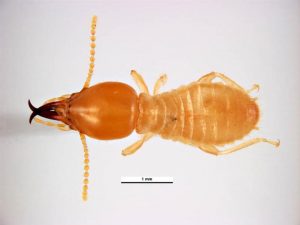
- Coptotermes Acinaciformis
Destructive Nature: They are highly destructive to buildings and other timber structures – the most widely distributed and destructive timber pest in Australia – accounts for more than 70% of the serious damage to buildings in Australia. A single colony may consist of more than one million termites. A most voracious timber pest … one to be taken seriously.
Nest Location: Coptotermes acinaciformis are very secretive termite species; they build their nest out of sight – often within the base of eucalyptus or other susceptible trees – or completely underground – often within an enclosed patio or under concrete on ground flooring which is ideal for moisture retention, temperature and humidity control within the termite colony’s central nest.
Area of Distribution: particularly in urban areas or where eucalypt gum trees are highly prevalent.
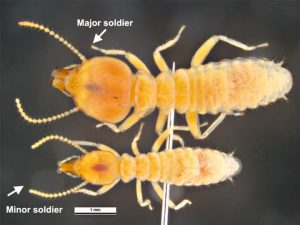
- Schedorhinotermes Intermedius
Destructive Nature: Schedorhinotermes Intermedius are highly destructive to buildings and other timber structures. If mostly major (larger) soldiers are sighted, then they will most likely be a large colony with the potential to cause severe and rapid damage to structural timbers of a building or other timber structures.
Nest Location: Schedorhinotermes Intermedius commonly build their nest in tree stumps, in the root crown of the living, dead and debilitated trees, under houses or within enclosed patios or other areas where timber has been buried or stored in contact with the soil.
Area of Distribution: Commonly found in eastern NSW and south eastern Queensland – particularly along the entire coast-line, the Great Dividing Range and adjoining slopes.

- Coptotermes Frenchi
Destructive Nature: Coptotermes Frenchi can cause severe damage to buildings and other wooden structures. It is common for this species to devour timber framing leaving only a thin veneer. This species is the most shy of the destructive species; they will retreat from a location immediately (for the time being) if disturbed.
Nest Location: Coptotermes Frenchi most often build their nest in the root crown or lower trunk area of living trees, particularly eucalypts. They may also build their nest as a mound in the dryer areas.
Area of Distribution: Commonly found throughout NSW; particularly in urban areas, where buildings are constructed of softwood or Oregon timber framing. This species is responsible for most of the timber pest damage to buildings in the NSW region.
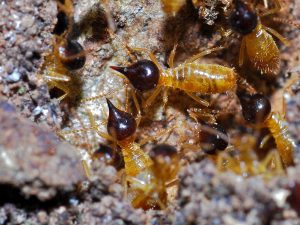
- Nasutitermes Exitiosus
Destructive Nature: Nasutitermes exitiosus are destructive to buildings and other timber structures. Sometimes severe damage may occur, but not as commonly as the other species listed above.
Nest Location: Nasutitermes exitiosus build a mound nest protruding 30cm to 75cm above the ground. Control can be as easy as knocking the top off the nest and a follow up insecticide treatment inside the nest.
Area of Distribution: Commonly found throughout NSW, ACT, Victoria and southern areas of Queensland and Western Australia – particularly in urban areas or where eucalypt gum trees are highly prevalent.

- Captotermes Lacteus
Destructive Nature: Coptotermes Lacteus attacks stumps, dead trees, timber fences, poles and other timber structures that are in contact with the soil, being softened by weathering or decay. These termites are also known to attack such timber in damp sub-floor areas.
Nest Location: This termite species, most often builds its nest as a mound up to 2m above ground level, with hard clay walls, so control is easily effected once located by knocking the top off and insecticide treatment of the nest.
Area of Distribution: Commonly found in eastern NSW, ACT and south eastern areas of Queensland including Brisbane and coastal region to Rockhampton – particularly prevalent along the entire coast-line, along the Great Dividing Range and western slopes.

- Nasutitermes Walkeri
Destructive Nature: Nasutitermes Walkeri can be destructive to damp timbers often a serious problem where the sub-floor of a building is damp and ventilation is poor with resulting wood decay or fungal growth.
Nest Location: Nasutitermes Walkeri build their nest in trees on the main trunk or in the fork of a large branch.
Area of Distribution: Commonly found in eastern NSW and south eastern Queensland – particularly prevalent in the coastal and mountain regions along the entire eastern side of NSW.
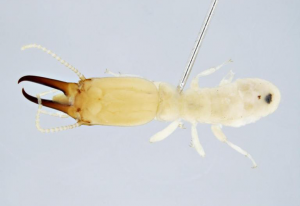
- Heterotermes Ferox
Destructive Nature: Heterotermes Ferox prefer damp timbers; are usually found in fences, poles and other timber structures with wood decay from weathering. Often confused with the more destructive Coptotermes acinaciformis species. Correct identification is essential.
Nest Location: Heterotermes Ferox often build their nest next to stumps, logs, or other timber with soil contact where some wood decay or rotting is prevalent.
Area of Distribution: Commonly found throughout NSW, ACT and southern parts of South Australia and Western Australia – particularly in urban areas or where eucalypt gum trees are highly prevalent.
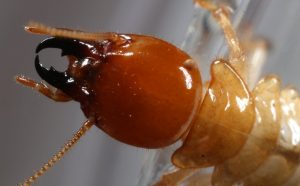
- Mastotermes Darwiniensis
Destructive Nature: Mastotermes Darwiniensis is one of the world’s most destructive termite species, often causing severe damage to houses, buildings, bridges, posts, poles, and many other plant and animal products. Mastotermes Darwiniensis is also an agricultural pest, responsible for ringbarking and killing trees, fruit & vegetable crops, sugarcane and rubber trees.
Nest Location: Mastotermes Darwiniensis build their nest (secretively) totally below the soil surface; or in the trunks and root crowns of trees and stumps. Once a nest is mature (over 100,000 or much higher) they can “split off” to form other nests over a wide ranging area.
Area of Distribution: Commonly found in tropical Northern Territory, parts of QLD and WA.
Voracious Appetite: Mastotermes Darwiniensis is reported to attack rubber tyres on tractors and cause damage to leather, hide, plastic or lead-sheathed cables, bitumen, bagged salt, flour, glass and various metals. Mastotermes Darwiniensis is the most ancient of all the termites in the world – they occur only in Australia – a termite to be feared.

- Dampwood Termites
Destructive Nature: Form small independent nests; they feed on sick or dead trees, decaying wood in the ground or in buildings and fences; they are seldom found in dry timbers in buildings; and are normally larger in size than other termite species.
Area of Distribution: Dampwood termites are found across highland and coastal Victoria, NSW, Queensland, NT and SA.
Top Termite Signs to Look for in Your Home!
Termites can often live on your property or inside your home for an extended period of time before being detected. Whether it’s Drywood termites, which burrow deep within wooden structures, or Subterranean termites, which are primarily found underground, these discreet intruders can be tough to discover before significant damage has already been done. To help keep damage to a minimum, it’s crucial to catch the warning signs as soon as possible.
Keep an eye out for the following signs of termite infestation:
- Termite soldiers’ head banging: Soldier make quiet clicking sounds by banging their heads against the wood or shaking their bodies to warn other termites when the colony is disturbed. If you put your ear close to the infested wood you can hear the soldiers’ head banging and even workers’ munching.
-
Piles of termite droppings (frass) in and around the home: Unlike subterranean termites, Drywood termites don’t use their faeces to build their tunnels. They nest inside the wood. While eating the wood they’re infesting, they make galleries they like to keep them clean by creating kick out holes where they push their poo out. This result in piles of frass in and around the infested areas which resembling sawdust or coffee grounds.
-
Piles of wings: Piles of discarded wings often resembling fish scales might be found near closed doors, windows and other home-access points. This is caused when termites swarm out of their nest to mate and find a place to set up a new colony. After landing they twist their wings off intentionally because they’ll never need them again. Unlike ants, termite wings are all the same size.
-
Flying termites: Most species of termites swarm during the spring and summer months (mainly during the November-December and March-April period, avoiding the very hot period of January-February), typically on a warm day with calm winds after a rainfall. So, if you see flying termites this could be a good sign that a new colony of termites is about to set up in or around your home and a massive infestation is on the way.
-
Presence of termites, mistakably known as “white ants”: Most of people confuse termites with ants and mistakably call them “white ants”. Termites are mostly pale brown to white in colour and can sometimes look quite translucent. You need to know that there’s no such thing as a white ant in any ant species. So, if you think that you’ve spotted a bug which looks like a white ant in and around your home then you might have termite.
-
Mud tubes: These tubes are normally pencil-sized and can be found wherever the ground meets your home or any other possible food source like a tree or shed. Termites make the tubes to protect them from predators, to block out cool and dry air and to maintain a dark and humid environment for the food storage and their development. You may find these mud tubes on the wood framings, on the external and internal walls, in the wall crevices, on the floor, on the ceiling, on the pavements and even on the garden trees.
-
Peeling paint that resembles water damage: Uneven or bubbling paint is often a sign of moisture build up, which could mean one of two things; water damage or termites. Termites produce moisture while eating the wood and tunnelling. The wood becomes hollow from inside and as a result the moist can easily be transferred to outer layers of timber where covered by paint. It makes the paint bumpy, warping, bubbling and spongy when touched.
-
Hollow sounding timber: Termites usually eat timber from the inside out without damaging the outermost layer. If you tap or knock lightly on an infested area with a solid object, it will sound empty and papery. That is because the inner layers of the timber has been consumed away by termites. Some of the housekeepers may discover the hollow infested timber pretty accidentally when their vacuum cleaner goes through the skirting boards or their fingers go through window or door frame while cleaning.
-
Sagging floorboards or loose tiles: If there’s any termite infestation in the flooring or subfloor, the surface of your wooden or laminate floorboards may be felt sagging, crumbling and even excessively squeaky while walking on them. The same thing may happen to the floor tiles as termite’s activity adds more moisture to the floor under the tiles which makes them loose.
-
Stuck windows or doors: Moisture from termite’s infestation can cause wood frames to expand. If you’re struggling to open a window or a tight-fitting door in your home, termites may be the cause.
-
Damaged garden timbers: The outside of your property is literally the first spot where termites can gain access because of plenty of food sources and moisture in your garden which are the ideal conditions for termites’ activity. All the timbers used in your garden as bed borders, decks, verandas, fence posts, trees and even the mulch are at risk of a termite infestation. Spotting any sign of infestation such as mud tubes, pinpoint holes, hollow wood, piles of frass and tree nests must be considered as a serious problem. It is critically important to treat the existing infestation out of your home as soon as possible if you don’t want to risk attacking active termites into your home.
-
Termite nests in your garden: These nests are the mounds built on the trees and in smaller sizes on top of the fence posts. They must be treated immediately to prevent termites from infesting your home next, if they haven’t already.
DO NOT Ignore Termites, if you find any in or around your home. By keeping this fact in your mind that they work nonstop 24 hours, you’ll find out how irreparable and costly might be the damages they can make to your property, if you delay.
Unfortunately, even if you don’t see any sign of termites, that doesn’t mean they’re not there. Their infestation can go unnoticed for a while, and by the time damage is noticed, significant structural damage may already be occurred. That’s why you’d better be proactive when it comes to termite control. To help BUGZOFF protect your home, we recommend you to schedule a termite inspection on regular bases.
Housekeeping Preventative Measures & Control Tips
Most prevention procedures must be carried out by professional pest controllers in order to be effective. There are methods of control, however, that can be carried out around the home in order to reduce the risk of termite attack.
Indoors
- Fix any moisture problems inside the house such as leaking pipes, leaking faucets, leaking showers, poor plumbing or drainage.
- Fix any roof damage which may create damp areas suitable for termites.
- Get termite inspections done annually by a professional BUGZOFF exterminator.
Outdoors
- Seal cracks and holes on the outside of the home including entry points for utilities and pipes.
- Keep gutters and down pipes free of leaks and blockages to allow for effective drainage of rain water.
- Keep subfloor, basement and attic well ventilated and dry.
- Direct water from gutter, air conditioner and hot water system away from your house through properly functioning downspout extensions, splash blocks, pipes and hoses.
- Keep subfloor clear of any scrap wood, timber off cuts and any other wooden items.
- Keep mulch away from the permitter of your home, the foundation and any wooden structure.
- Stop growing of Vines, Ivy and other climbing plants on the wall of your home.
- Avoid planting trees and shrubs next to your home. They should be at least 50 cm to a few meters away from the foundation depending on their growth and size.
- Avoid using wooden borders to edge your beds in the garden.
- Use timbers which show varying degrees of resistance to most termite species. These include: American Redwood, Black Bean, Bloodwood, Jam Acacia, River Red Gum, Southern Cypress (USA) and White Cypress Pine.
- Keep sprinklers away from the home foundation. And put them right in the garden or on the lawn when needed.
- Remove any wood that’s in contact with the ground and close to the house. So, store firewood about 10 meter away from the foundation and 10 cm off the ground.
- Paving should be level or graded away from the house so that water doesn’t pool against walls.
- Keep the weep holes (the small gaps left between bricks to let water drain out) clear of mulch, wood chips, scrap wood, shrubs or garden beds.
- Get termite inspections done annually by a professional BUGZOFF exterminator.
Housekeeper’s Pre-treatment Cooperation
- DO NOT DISTURB TERMITES, if you find them; certain termite species if left uncontrolled can cause a severe amount of damage to a building in a short amount of time. If you find termites in or around your property, it is essential that you do NOT disturb them because it will frighten them off and makes it harder to treat them. Promptly contact our BUGZOFF termite specialists for an inspection of the property and advice on the protective measures available.
- DO NOT Kill TERMITES with insecticides or any other DIY methods which you find on the internet.
Contact Us
Phone:
+61423203356
Email:
support@bugzoff.com.au
Servicing Sydney
Metropolitan Areas
Fully licensed and insured

BUGZOFF Pest Control has been serving comprehensive pest control and termite services to residential and commercial customers throughout Sydney metropolitan areas for nearly 10 years now.
Main Menu
Quick Contact
Contact info


